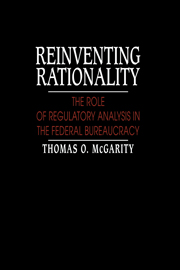Book contents
- Frontmatter
- Contents
- Acknowledgments
- Abbreviations
- Introduction
- Part I The clash of regulatory cultures
- Part II Regulatory analysis in theory and practice
- 3 Getting the lead out of gasoline: EPA's lead phasedown regulations
- 4 Getting the dust out of the air: EPA's ambient air quality standard for particulate matter
- 5 Getting obstructions out of the driver's view: NHTSA's field of direct view regulations
- 6 Getting the bone out of processed meat: FSIS's mechanically separated meat standard
- 7 Getting information into hazardous workplaces: OSHA's hazard identification regulations
- 8 The virtues of regulatory analysis
- 9 Limitations of regulatory analysis
- 10 Regulatory analysis in the real world
- Part III Structuring regulatory analysis into the decisionmaking process
- Part IV Review of regulatory analysis
- Part V Conclusions
- Notes
- Bibliography
- Index
10 - Regulatory analysis in the real world
Published online by Cambridge University Press: 16 October 2009
- Frontmatter
- Contents
- Acknowledgments
- Abbreviations
- Introduction
- Part I The clash of regulatory cultures
- Part II Regulatory analysis in theory and practice
- 3 Getting the lead out of gasoline: EPA's lead phasedown regulations
- 4 Getting the dust out of the air: EPA's ambient air quality standard for particulate matter
- 5 Getting obstructions out of the driver's view: NHTSA's field of direct view regulations
- 6 Getting the bone out of processed meat: FSIS's mechanically separated meat standard
- 7 Getting information into hazardous workplaces: OSHA's hazard identification regulations
- 8 The virtues of regulatory analysis
- 9 Limitations of regulatory analysis
- 10 Regulatory analysis in the real world
- Part III Structuring regulatory analysis into the decisionmaking process
- Part IV Review of regulatory analysis
- Part V Conclusions
- Notes
- Bibliography
- Index
Summary
Given the impressive array of debilitating limitations explored in Chapter 9, it should not surprise the reader to discover that analysis suffers considerably in its real world application. Despite the practical problems that plagued the analytical enterprise in the case studies examined in Chapters 3 to 7, they represent success stories; the agencies threw enough resources into the endeavor to give the analytical effort a fighting chance. The vast majority of regulatory analyses do not receive the kind of detailed attention that the agencies devoted to the analyses described in those chapters. Yet, most executive agencies attempt to honor the spirit of the analysis requirements, and some have devoted serious attention to beefing up their analytical capabilities.
This chapter will explore the commitment to analysis that executive agencies typically make on paper and in the real world. Its primary focus will be on EPA, OSHA, NHTSA, FA A, and four agencies in USDA. It will examine in a general way the analytical sophistication of agency regulatory analysis documents, paying particular attention to how they go about quantifying costs and benefits, stating assumptions, and characterizing uncertainties. It will also probe the extent to which regulatory analysts attempt to identify and evaluate innovative options that may go beyond the agency's statutory authority. Finally, it will examine briefly the impact of regulatory analysis on public participation in agency decisionmaking. We shall see wide variations among agencies, and even within agencies, in the level of analysis achieved in a typical rulemaking. None of the agencies, however, comes close to meeting the comprehensive analytical rationality ideal.
- Type
- Chapter
- Information
- Reinventing RationalityThe Role of Regulatory Analysis in the Federal Bureaucracy, pp. 165 - 176Publisher: Cambridge University PressPrint publication year: 1991



